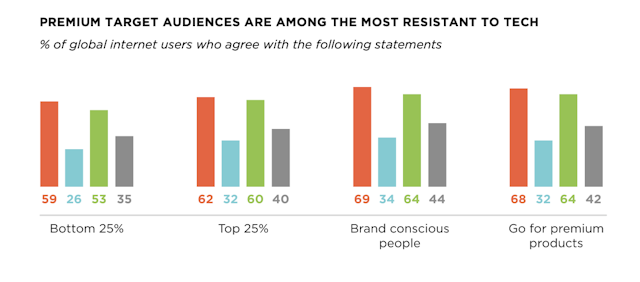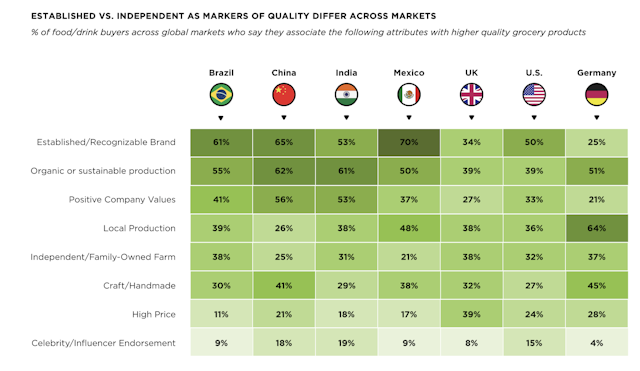Luxury brands must be human first
Consumers across the globe are stuck in a precarious position when it comes to technology. They want the conveniences that technology provides yet they are increasingly concerned about its influence in their lives. This conundrum is referred to as “tech angst,” and no one feels it more than affluent audiences.

Worldwide Partners on why luxury goods brands and marketers should embrace a more personalised marketing model.
In our recent research with GlobalWebIndex, we found that premium target audiences were 20% more likely to say that technology makes their lives more complicated. Premium audiences are also 21% more likely to prefer anonymity when using the internet. And the Covid-19 crisis has only exacerbated tech fatigue by more closely tying consumers to their devices during lockdown.

Source: From CX to HX, Worldwide Partners & GlobalWebIndex report, 2020
This increased tech angst in wealthy markets and the steps consumers are taking to find relief has fundamentally changed the way in which luxury brands must market their products and services.
Luxury of disconnecting
“High tech” used to be a premium, reserved for affluent and high-powered groups. That’s no longer the case. Today, tech is cheap, it’s easy and it’s everywhere. It’s the great equalizer of nearly every society across the world.
This democratization has led to a reverse of exclusivity. Having a device and being tied to it at every waking moment (and most sleeping moments too!) is a fundamental part of mass culture. To highlight their premium status, luxury consumers are taking every opportunity to log off and get off the grid.
Turning your device off for the evening to spend time with family and friends. Leaving the phone at home while you go on a weekend getaway. Closing your laptop to eat lunch in a different room. These disconnecting activities have become a status symbol for more wealthy audiences.
With more limited digital activity, luxury brands seeking to reach their target audience must leverage non-digital platforms and balance their digital footprint with human-first messaging, experience and activities.
“It is important to emphasize the value behind luxury goods,” says Filip Libal, CEO of Worldwide Partners agency Proboston, based in Prague, Czech Republic. “Luxury goods no longer serve as a demonstrative status symbol as they once did. Rather, they now showcase a way of preserving value, an investment.”
Human touch is a premium
No one would deny that technology has facilitated innovative marketing. Yet, we also can’t deny that it has inevitably created a barrier between the consumer and the brand. For FMCG brands, this barrier may be surmountable. For premium or luxury brands, however, it threatens to become an impasse.
Luxury brands and marketers can respond now to consumers’ growing pain points around technology by utilizing a truly premium commodity - the human touch.
Providing luxury consumers with avenues for real person-to-person interaction--the ability to ask questions, get advice and understand how a product is made and used from an actual human contact--keeps customers connected and coming back for more.
Localizing luxury
Luxury is not the same in every country and market. What is considered high quality in one region may not appeal to another, or worse, may actually be perceived as less valuable.
The difference is found between mature and emerging markets. In mature markets, disruption and uniqueness are what grab the attention of consumers. Traits like “craft,” “handmade,” and “independent” are more likely to be associated with higher quality products.
In emerging markets, however, it’s larger, more well-known brands that are associated with higher quality. For example, in China 65% of food buyers are more likely to go for well-known, recognized brands while just 25% of German consumers are interested in established brands.

Source: From CX to HX, Worldwide Partners & GlobalWebIndex report, 2020
“Human experience can elevate brands from transaction experience to brand culture experience, resulting in stronger trust and better customer relationships,” says Helen Lo, head of strategic planning of Worldwide Partners agency WE Marketing Group based in Shanghai.
More than ever, luxury brands and marketers need to take a local approach to ensure they’re utilizing the messaging, platforms, and media to connect with their target audiences.
As premium audiences continue to recoil from tech fatigue, luxury goods brands and marketers must embrace a new marketing model that is personal not personalized, that empowers humans not targets customers, that is human-first not tech-first. Luxury brands need to deliver a human experience to the humans they’re trying to reach.
Angie Pascale, social media and content at Worldwide Partners.
This article originally appeared in The Drum Network's Luxury Supplement '20.
Content by The Drum Network member:

Worldwide Partners Inc.
Worldwide Partners, Inc. (WPI) is one of the world’s largest networks of independent advertising and marketing communications agencies, comprised of over 70 independent...
Find out more
